Professional Accountability And Patient Safety
VerifiedAdded on 2023/04/12
|10
|2566
|376
AI Summary
This paper analyzes a case of professional misconduct in nursing, focusing on the circumstances, decisions made, and the impact on patient safety. It highlights the importance of adhering to professional codes of conduct and guidelines to ensure accountability and promote patient well-being.
Contribute Materials
Your contribution can guide someone’s learning journey. Share your
documents today.
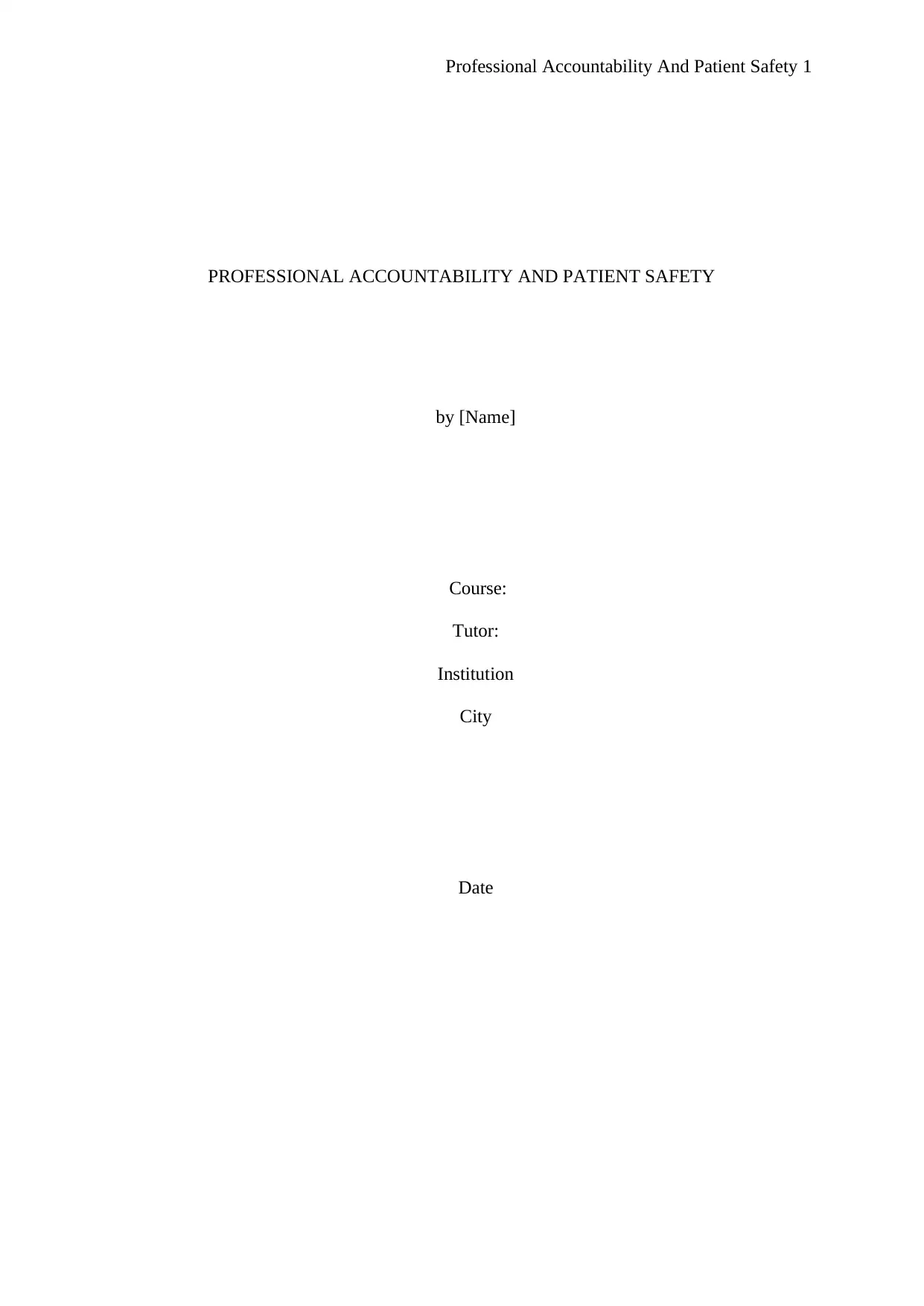
Professional Accountability And Patient Safety 1
PROFESSIONAL ACCOUNTABILITY AND PATIENT SAFETY
by [Name]
Course:
Tutor:
Institution
City
Date
PROFESSIONAL ACCOUNTABILITY AND PATIENT SAFETY
by [Name]
Course:
Tutor:
Institution
City
Date
Secure Best Marks with AI Grader
Need help grading? Try our AI Grader for instant feedback on your assignments.
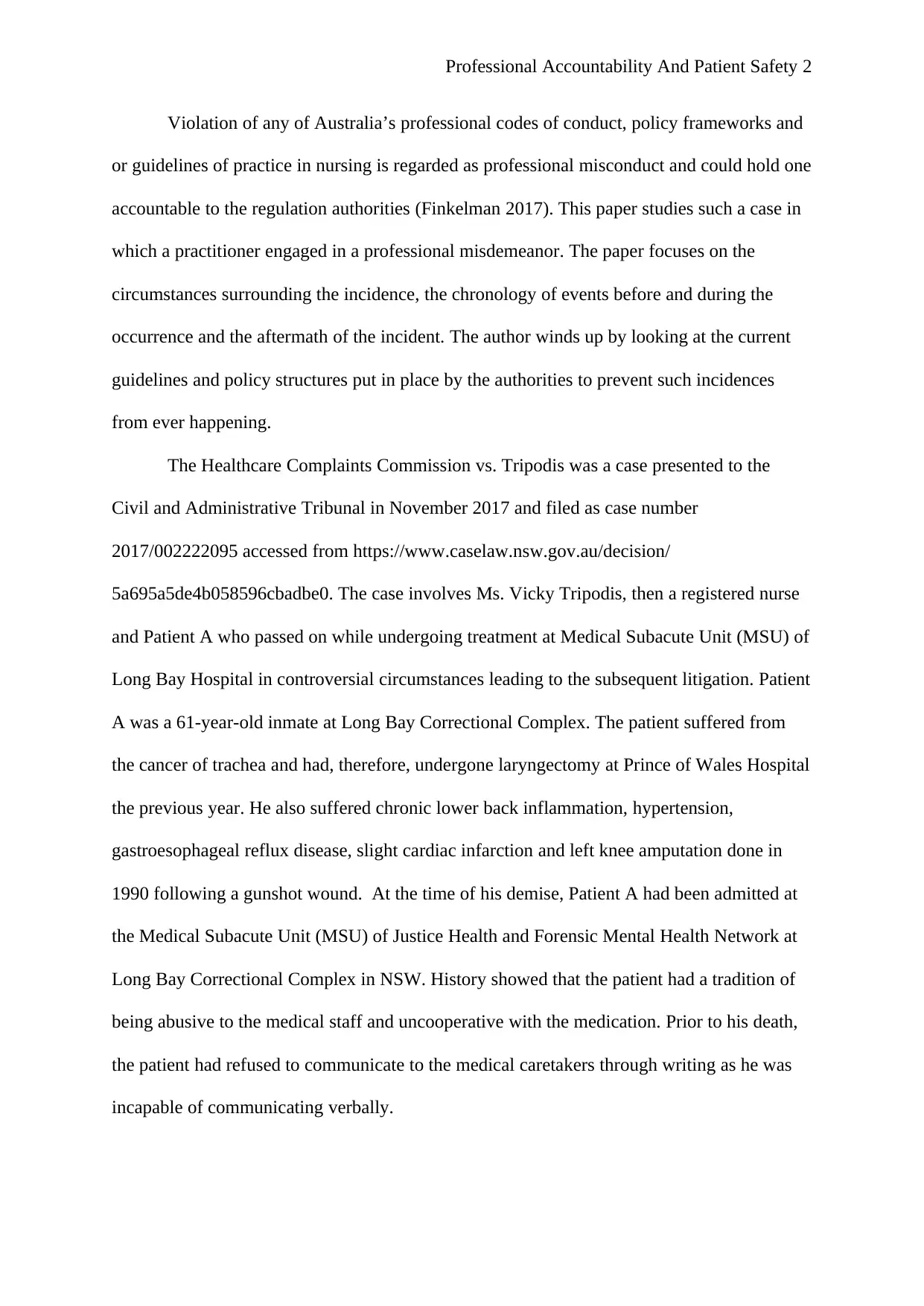
Professional Accountability And Patient Safety 2
Violation of any of Australia’s professional codes of conduct, policy frameworks and
or guidelines of practice in nursing is regarded as professional misconduct and could hold one
accountable to the regulation authorities (Finkelman 2017). This paper studies such a case in
which a practitioner engaged in a professional misdemeanor. The paper focuses on the
circumstances surrounding the incidence, the chronology of events before and during the
occurrence and the aftermath of the incident. The author winds up by looking at the current
guidelines and policy structures put in place by the authorities to prevent such incidences
from ever happening.
The Healthcare Complaints Commission vs. Tripodis was a case presented to the
Civil and Administrative Tribunal in November 2017 and filed as case number
2017/002222095 accessed from https://www.caselaw.nsw.gov.au/decision/
5a695a5de4b058596cbadbe0. The case involves Ms. Vicky Tripodis, then a registered nurse
and Patient A who passed on while undergoing treatment at Medical Subacute Unit (MSU) of
Long Bay Hospital in controversial circumstances leading to the subsequent litigation. Patient
A was a 61-year-old inmate at Long Bay Correctional Complex. The patient suffered from
the cancer of trachea and had, therefore, undergone laryngectomy at Prince of Wales Hospital
the previous year. He also suffered chronic lower back inflammation, hypertension,
gastroesophageal reflux disease, slight cardiac infarction and left knee amputation done in
1990 following a gunshot wound. At the time of his demise, Patient A had been admitted at
the Medical Subacute Unit (MSU) of Justice Health and Forensic Mental Health Network at
Long Bay Correctional Complex in NSW. History showed that the patient had a tradition of
being abusive to the medical staff and uncooperative with the medication. Prior to his death,
the patient had refused to communicate to the medical caretakers through writing as he was
incapable of communicating verbally.
Violation of any of Australia’s professional codes of conduct, policy frameworks and
or guidelines of practice in nursing is regarded as professional misconduct and could hold one
accountable to the regulation authorities (Finkelman 2017). This paper studies such a case in
which a practitioner engaged in a professional misdemeanor. The paper focuses on the
circumstances surrounding the incidence, the chronology of events before and during the
occurrence and the aftermath of the incident. The author winds up by looking at the current
guidelines and policy structures put in place by the authorities to prevent such incidences
from ever happening.
The Healthcare Complaints Commission vs. Tripodis was a case presented to the
Civil and Administrative Tribunal in November 2017 and filed as case number
2017/002222095 accessed from https://www.caselaw.nsw.gov.au/decision/
5a695a5de4b058596cbadbe0. The case involves Ms. Vicky Tripodis, then a registered nurse
and Patient A who passed on while undergoing treatment at Medical Subacute Unit (MSU) of
Long Bay Hospital in controversial circumstances leading to the subsequent litigation. Patient
A was a 61-year-old inmate at Long Bay Correctional Complex. The patient suffered from
the cancer of trachea and had, therefore, undergone laryngectomy at Prince of Wales Hospital
the previous year. He also suffered chronic lower back inflammation, hypertension,
gastroesophageal reflux disease, slight cardiac infarction and left knee amputation done in
1990 following a gunshot wound. At the time of his demise, Patient A had been admitted at
the Medical Subacute Unit (MSU) of Justice Health and Forensic Mental Health Network at
Long Bay Correctional Complex in NSW. History showed that the patient had a tradition of
being abusive to the medical staff and uncooperative with the medication. Prior to his death,
the patient had refused to communicate to the medical caretakers through writing as he was
incapable of communicating verbally.
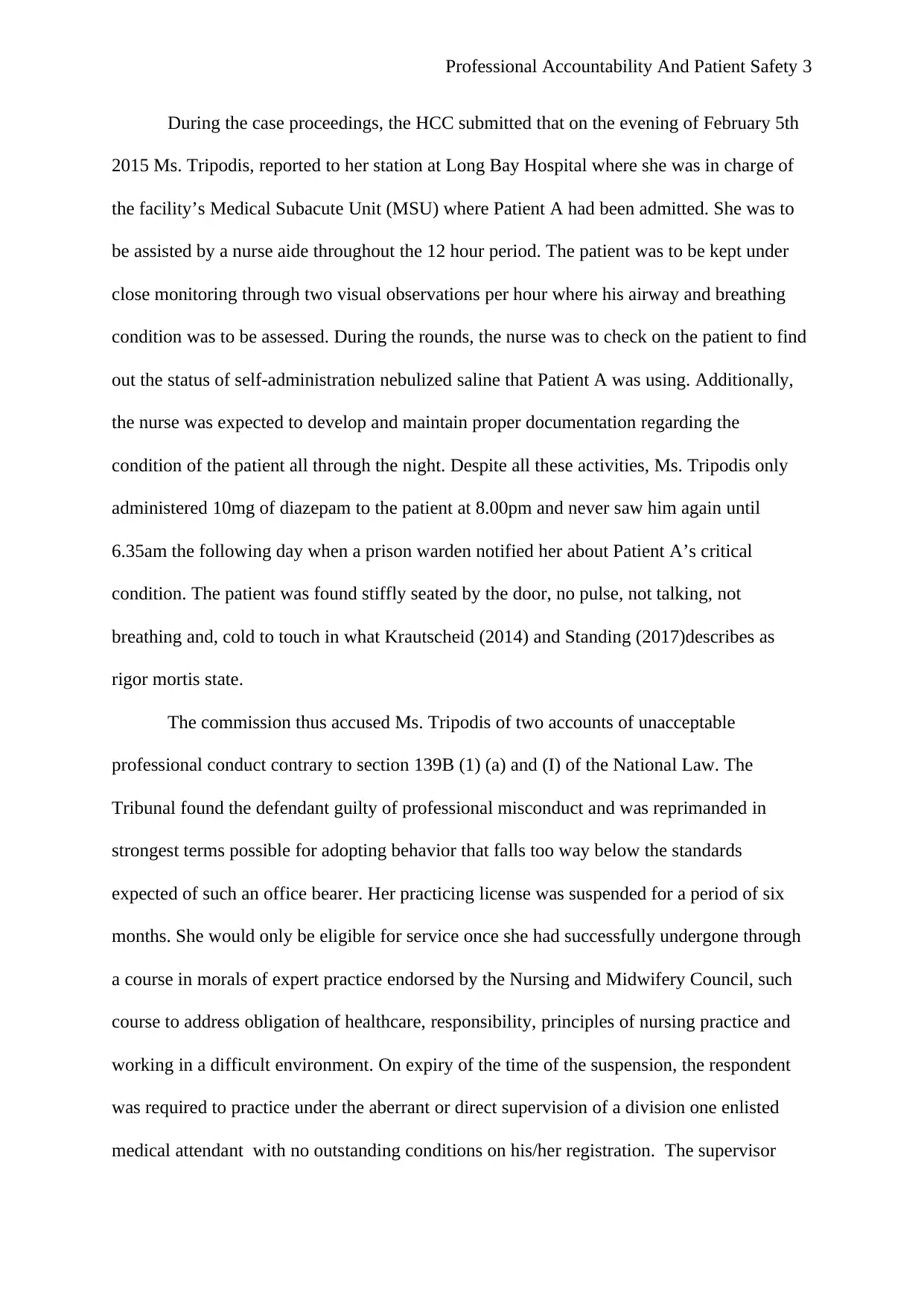
Professional Accountability And Patient Safety 3
During the case proceedings, the HCC submitted that on the evening of February 5th
2015 Ms. Tripodis, reported to her station at Long Bay Hospital where she was in charge of
the facility’s Medical Subacute Unit (MSU) where Patient A had been admitted. She was to
be assisted by a nurse aide throughout the 12 hour period. The patient was to be kept under
close monitoring through two visual observations per hour where his airway and breathing
condition was to be assessed. During the rounds, the nurse was to check on the patient to find
out the status of self-administration nebulized saline that Patient A was using. Additionally,
the nurse was expected to develop and maintain proper documentation regarding the
condition of the patient all through the night. Despite all these activities, Ms. Tripodis only
administered 10mg of diazepam to the patient at 8.00pm and never saw him again until
6.35am the following day when a prison warden notified her about Patient A’s critical
condition. The patient was found stiffly seated by the door, no pulse, not talking, not
breathing and, cold to touch in what Krautscheid (2014) and Standing (2017)describes as
rigor mortis state.
The commission thus accused Ms. Tripodis of two accounts of unacceptable
professional conduct contrary to section 139B (1) (a) and (I) of the National Law. The
Tribunal found the defendant guilty of professional misconduct and was reprimanded in
strongest terms possible for adopting behavior that falls too way below the standards
expected of such an office bearer. Her practicing license was suspended for a period of six
months. She would only be eligible for service once she had successfully undergone through
a course in morals of expert practice endorsed by the Nursing and Midwifery Council, such
course to address obligation of healthcare, responsibility, principles of nursing practice and
working in a difficult environment. On expiry of the time of the suspension, the respondent
was required to practice under the aberrant or direct supervision of a division one enlisted
medical attendant with no outstanding conditions on his/her registration. The supervisor
During the case proceedings, the HCC submitted that on the evening of February 5th
2015 Ms. Tripodis, reported to her station at Long Bay Hospital where she was in charge of
the facility’s Medical Subacute Unit (MSU) where Patient A had been admitted. She was to
be assisted by a nurse aide throughout the 12 hour period. The patient was to be kept under
close monitoring through two visual observations per hour where his airway and breathing
condition was to be assessed. During the rounds, the nurse was to check on the patient to find
out the status of self-administration nebulized saline that Patient A was using. Additionally,
the nurse was expected to develop and maintain proper documentation regarding the
condition of the patient all through the night. Despite all these activities, Ms. Tripodis only
administered 10mg of diazepam to the patient at 8.00pm and never saw him again until
6.35am the following day when a prison warden notified her about Patient A’s critical
condition. The patient was found stiffly seated by the door, no pulse, not talking, not
breathing and, cold to touch in what Krautscheid (2014) and Standing (2017)describes as
rigor mortis state.
The commission thus accused Ms. Tripodis of two accounts of unacceptable
professional conduct contrary to section 139B (1) (a) and (I) of the National Law. The
Tribunal found the defendant guilty of professional misconduct and was reprimanded in
strongest terms possible for adopting behavior that falls too way below the standards
expected of such an office bearer. Her practicing license was suspended for a period of six
months. She would only be eligible for service once she had successfully undergone through
a course in morals of expert practice endorsed by the Nursing and Midwifery Council, such
course to address obligation of healthcare, responsibility, principles of nursing practice and
working in a difficult environment. On expiry of the time of the suspension, the respondent
was required to practice under the aberrant or direct supervision of a division one enlisted
medical attendant with no outstanding conditions on his/her registration. The supervisor
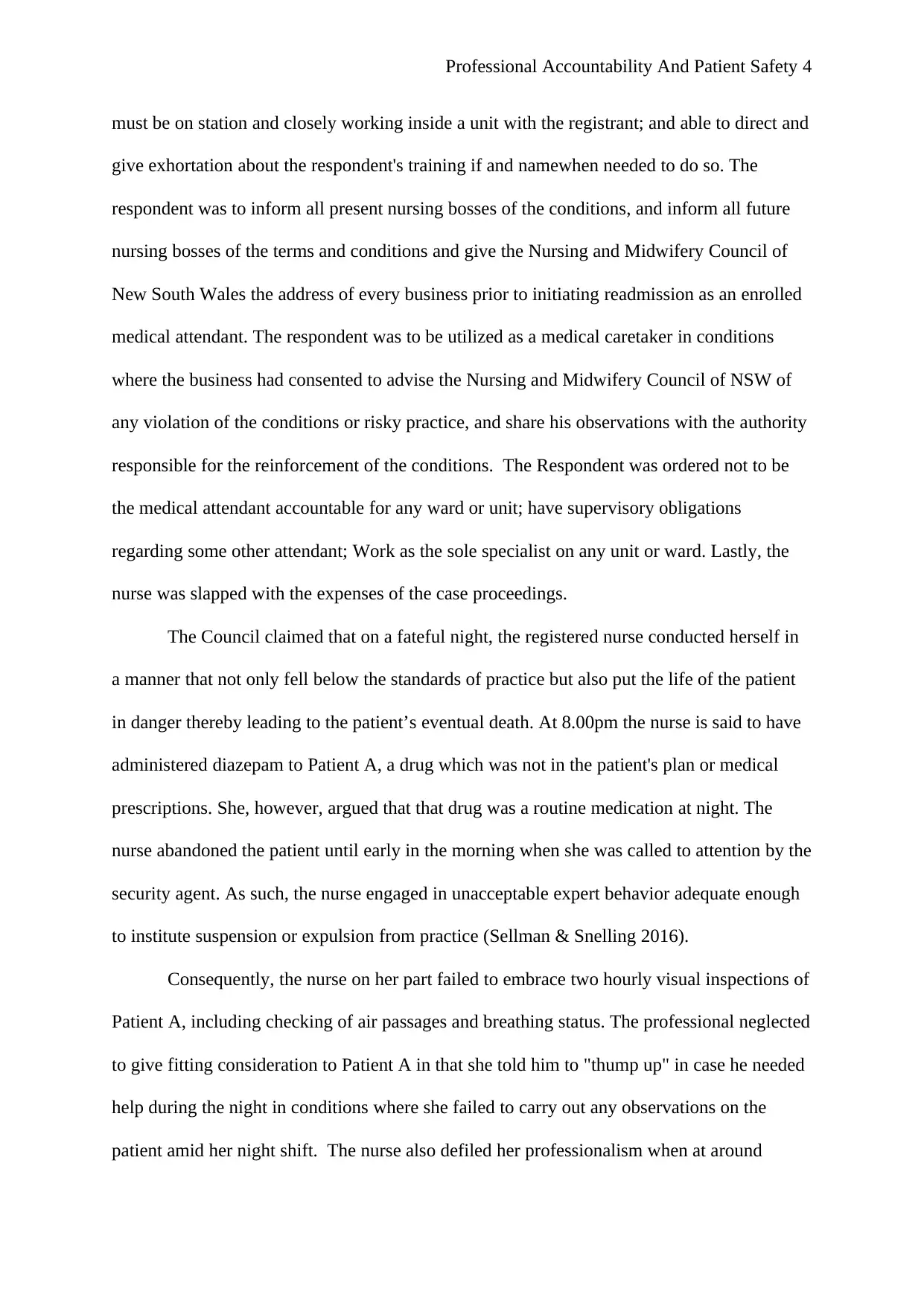
Professional Accountability And Patient Safety 4
must be on station and closely working inside a unit with the registrant; and able to direct and
give exhortation about the respondent's training if and namewhen needed to do so. The
respondent was to inform all present nursing bosses of the conditions, and inform all future
nursing bosses of the terms and conditions and give the Nursing and Midwifery Council of
New South Wales the address of every business prior to initiating readmission as an enrolled
medical attendant. The respondent was to be utilized as a medical caretaker in conditions
where the business had consented to advise the Nursing and Midwifery Council of NSW of
any violation of the conditions or risky practice, and share his observations with the authority
responsible for the reinforcement of the conditions. The Respondent was ordered not to be
the medical attendant accountable for any ward or unit; have supervisory obligations
regarding some other attendant; Work as the sole specialist on any unit or ward. Lastly, the
nurse was slapped with the expenses of the case proceedings.
The Council claimed that on a fateful night, the registered nurse conducted herself in
a manner that not only fell below the standards of practice but also put the life of the patient
in danger thereby leading to the patient’s eventual death. At 8.00pm the nurse is said to have
administered diazepam to Patient A, a drug which was not in the patient's plan or medical
prescriptions. She, however, argued that that drug was a routine medication at night. The
nurse abandoned the patient until early in the morning when she was called to attention by the
security agent. As such, the nurse engaged in unacceptable expert behavior adequate enough
to institute suspension or expulsion from practice (Sellman & Snelling 2016).
Consequently, the nurse on her part failed to embrace two hourly visual inspections of
Patient A, including checking of air passages and breathing status. The professional neglected
to give fitting consideration to Patient A in that she told him to "thump up" in case he needed
help during the night in conditions where she failed to carry out any observations on the
patient amid her night shift. The nurse also defiled her professionalism when at around
must be on station and closely working inside a unit with the registrant; and able to direct and
give exhortation about the respondent's training if and namewhen needed to do so. The
respondent was to inform all present nursing bosses of the conditions, and inform all future
nursing bosses of the terms and conditions and give the Nursing and Midwifery Council of
New South Wales the address of every business prior to initiating readmission as an enrolled
medical attendant. The respondent was to be utilized as a medical caretaker in conditions
where the business had consented to advise the Nursing and Midwifery Council of NSW of
any violation of the conditions or risky practice, and share his observations with the authority
responsible for the reinforcement of the conditions. The Respondent was ordered not to be
the medical attendant accountable for any ward or unit; have supervisory obligations
regarding some other attendant; Work as the sole specialist on any unit or ward. Lastly, the
nurse was slapped with the expenses of the case proceedings.
The Council claimed that on a fateful night, the registered nurse conducted herself in
a manner that not only fell below the standards of practice but also put the life of the patient
in danger thereby leading to the patient’s eventual death. At 8.00pm the nurse is said to have
administered diazepam to Patient A, a drug which was not in the patient's plan or medical
prescriptions. She, however, argued that that drug was a routine medication at night. The
nurse abandoned the patient until early in the morning when she was called to attention by the
security agent. As such, the nurse engaged in unacceptable expert behavior adequate enough
to institute suspension or expulsion from practice (Sellman & Snelling 2016).
Consequently, the nurse on her part failed to embrace two hourly visual inspections of
Patient A, including checking of air passages and breathing status. The professional neglected
to give fitting consideration to Patient A in that she told him to "thump up" in case he needed
help during the night in conditions where she failed to carry out any observations on the
patient amid her night shift. The nurse also defiled her professionalism when at around
Secure Best Marks with AI Grader
Need help grading? Try our AI Grader for instant feedback on your assignments.
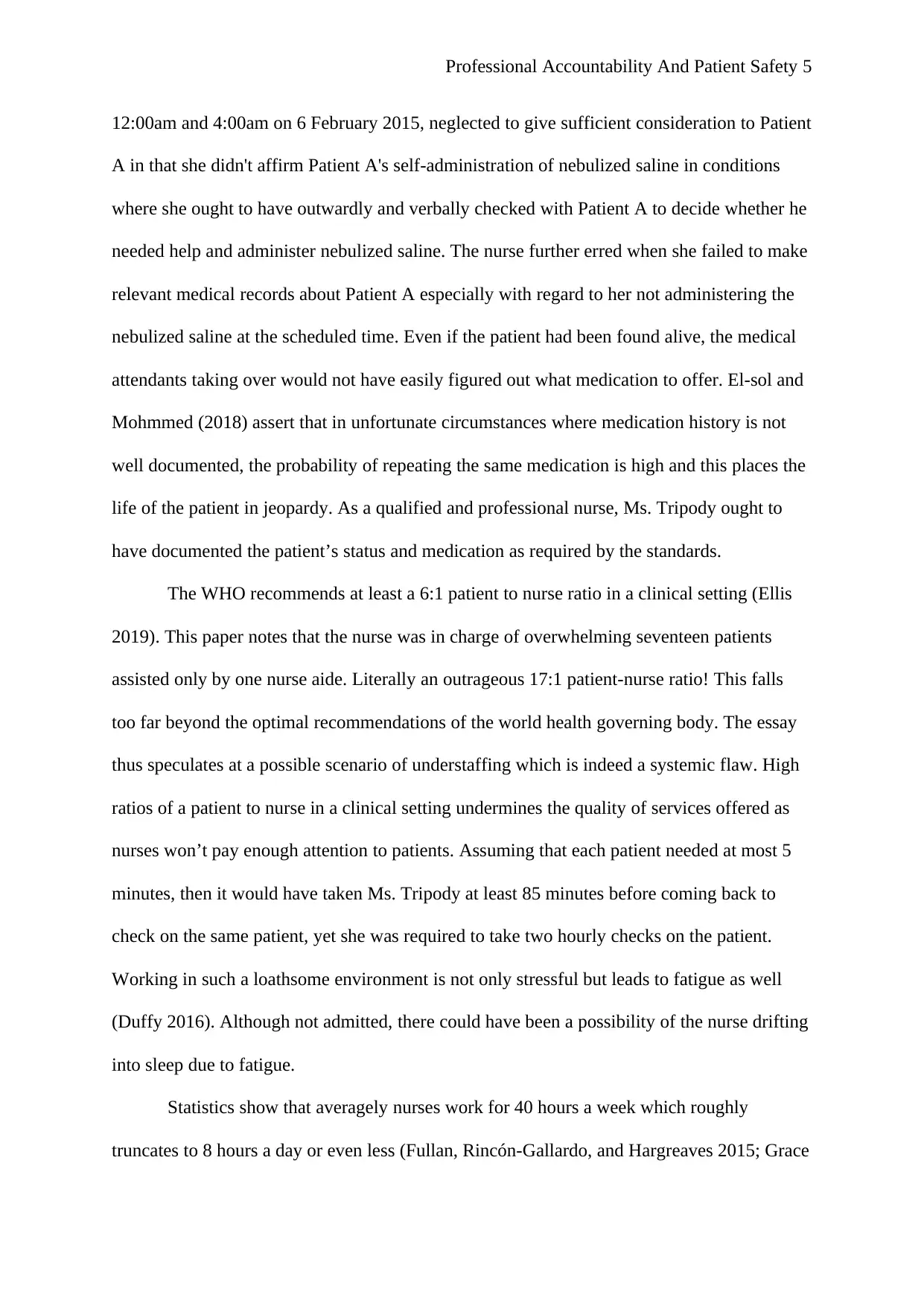
Professional Accountability And Patient Safety 5
12:00am and 4:00am on 6 February 2015, neglected to give sufficient consideration to Patient
A in that she didn't affirm Patient A's self-administration of nebulized saline in conditions
where she ought to have outwardly and verbally checked with Patient A to decide whether he
needed help and administer nebulized saline. The nurse further erred when she failed to make
relevant medical records about Patient A especially with regard to her not administering the
nebulized saline at the scheduled time. Even if the patient had been found alive, the medical
attendants taking over would not have easily figured out what medication to offer. El-sol and
Mohmmed (2018) assert that in unfortunate circumstances where medication history is not
well documented, the probability of repeating the same medication is high and this places the
life of the patient in jeopardy. As a qualified and professional nurse, Ms. Tripody ought to
have documented the patient’s status and medication as required by the standards.
The WHO recommends at least a 6:1 patient to nurse ratio in a clinical setting (Ellis
2019). This paper notes that the nurse was in charge of overwhelming seventeen patients
assisted only by one nurse aide. Literally an outrageous 17:1 patient-nurse ratio! This falls
too far beyond the optimal recommendations of the world health governing body. The essay
thus speculates at a possible scenario of understaffing which is indeed a systemic flaw. High
ratios of a patient to nurse in a clinical setting undermines the quality of services offered as
nurses won’t pay enough attention to patients. Assuming that each patient needed at most 5
minutes, then it would have taken Ms. Tripody at least 85 minutes before coming back to
check on the same patient, yet she was required to take two hourly checks on the patient.
Working in such a loathsome environment is not only stressful but leads to fatigue as well
(Duffy 2016). Although not admitted, there could have been a possibility of the nurse drifting
into sleep due to fatigue.
Statistics show that averagely nurses work for 40 hours a week which roughly
truncates to 8 hours a day or even less (Fullan, Rincón-Gallardo, and Hargreaves 2015; Grace
12:00am and 4:00am on 6 February 2015, neglected to give sufficient consideration to Patient
A in that she didn't affirm Patient A's self-administration of nebulized saline in conditions
where she ought to have outwardly and verbally checked with Patient A to decide whether he
needed help and administer nebulized saline. The nurse further erred when she failed to make
relevant medical records about Patient A especially with regard to her not administering the
nebulized saline at the scheduled time. Even if the patient had been found alive, the medical
attendants taking over would not have easily figured out what medication to offer. El-sol and
Mohmmed (2018) assert that in unfortunate circumstances where medication history is not
well documented, the probability of repeating the same medication is high and this places the
life of the patient in jeopardy. As a qualified and professional nurse, Ms. Tripody ought to
have documented the patient’s status and medication as required by the standards.
The WHO recommends at least a 6:1 patient to nurse ratio in a clinical setting (Ellis
2019). This paper notes that the nurse was in charge of overwhelming seventeen patients
assisted only by one nurse aide. Literally an outrageous 17:1 patient-nurse ratio! This falls
too far beyond the optimal recommendations of the world health governing body. The essay
thus speculates at a possible scenario of understaffing which is indeed a systemic flaw. High
ratios of a patient to nurse in a clinical setting undermines the quality of services offered as
nurses won’t pay enough attention to patients. Assuming that each patient needed at most 5
minutes, then it would have taken Ms. Tripody at least 85 minutes before coming back to
check on the same patient, yet she was required to take two hourly checks on the patient.
Working in such a loathsome environment is not only stressful but leads to fatigue as well
(Duffy 2016). Although not admitted, there could have been a possibility of the nurse drifting
into sleep due to fatigue.
Statistics show that averagely nurses work for 40 hours a week which roughly
truncates to 8 hours a day or even less (Fullan, Rincón-Gallardo, and Hargreaves 2015; Grace
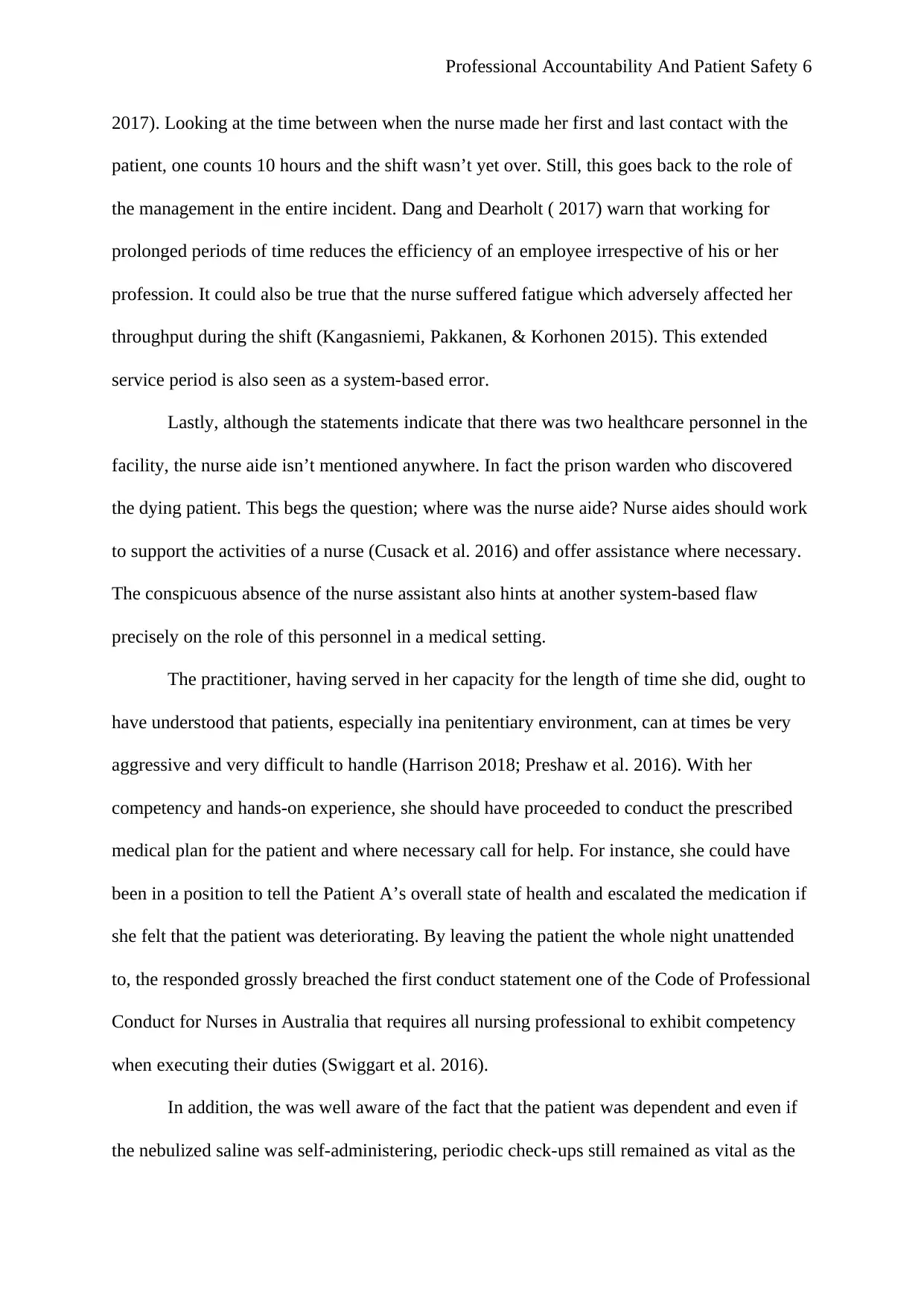
Professional Accountability And Patient Safety 6
2017). Looking at the time between when the nurse made her first and last contact with the
patient, one counts 10 hours and the shift wasn’t yet over. Still, this goes back to the role of
the management in the entire incident. Dang and Dearholt ( 2017) warn that working for
prolonged periods of time reduces the efficiency of an employee irrespective of his or her
profession. It could also be true that the nurse suffered fatigue which adversely affected her
throughput during the shift (Kangasniemi, Pakkanen, & Korhonen 2015). This extended
service period is also seen as a system-based error.
Lastly, although the statements indicate that there was two healthcare personnel in the
facility, the nurse aide isn’t mentioned anywhere. In fact the prison warden who discovered
the dying patient. This begs the question; where was the nurse aide? Nurse aides should work
to support the activities of a nurse (Cusack et al. 2016) and offer assistance where necessary.
The conspicuous absence of the nurse assistant also hints at another system-based flaw
precisely on the role of this personnel in a medical setting.
The practitioner, having served in her capacity for the length of time she did, ought to
have understood that patients, especially ina penitentiary environment, can at times be very
aggressive and very difficult to handle (Harrison 2018; Preshaw et al. 2016). With her
competency and hands-on experience, she should have proceeded to conduct the prescribed
medical plan for the patient and where necessary call for help. For instance, she could have
been in a position to tell the Patient A’s overall state of health and escalated the medication if
she felt that the patient was deteriorating. By leaving the patient the whole night unattended
to, the responded grossly breached the first conduct statement one of the Code of Professional
Conduct for Nurses in Australia that requires all nursing professional to exhibit competency
when executing their duties (Swiggart et al. 2016).
In addition, the was well aware of the fact that the patient was dependent and even if
the nebulized saline was self-administering, periodic check-ups still remained as vital as the
2017). Looking at the time between when the nurse made her first and last contact with the
patient, one counts 10 hours and the shift wasn’t yet over. Still, this goes back to the role of
the management in the entire incident. Dang and Dearholt ( 2017) warn that working for
prolonged periods of time reduces the efficiency of an employee irrespective of his or her
profession. It could also be true that the nurse suffered fatigue which adversely affected her
throughput during the shift (Kangasniemi, Pakkanen, & Korhonen 2015). This extended
service period is also seen as a system-based error.
Lastly, although the statements indicate that there was two healthcare personnel in the
facility, the nurse aide isn’t mentioned anywhere. In fact the prison warden who discovered
the dying patient. This begs the question; where was the nurse aide? Nurse aides should work
to support the activities of a nurse (Cusack et al. 2016) and offer assistance where necessary.
The conspicuous absence of the nurse assistant also hints at another system-based flaw
precisely on the role of this personnel in a medical setting.
The practitioner, having served in her capacity for the length of time she did, ought to
have understood that patients, especially ina penitentiary environment, can at times be very
aggressive and very difficult to handle (Harrison 2018; Preshaw et al. 2016). With her
competency and hands-on experience, she should have proceeded to conduct the prescribed
medical plan for the patient and where necessary call for help. For instance, she could have
been in a position to tell the Patient A’s overall state of health and escalated the medication if
she felt that the patient was deteriorating. By leaving the patient the whole night unattended
to, the responded grossly breached the first conduct statement one of the Code of Professional
Conduct for Nurses in Australia that requires all nursing professional to exhibit competency
when executing their duties (Swiggart et al. 2016).
In addition, the was well aware of the fact that the patient was dependent and even if
the nebulized saline was self-administering, periodic check-ups still remained as vital as the
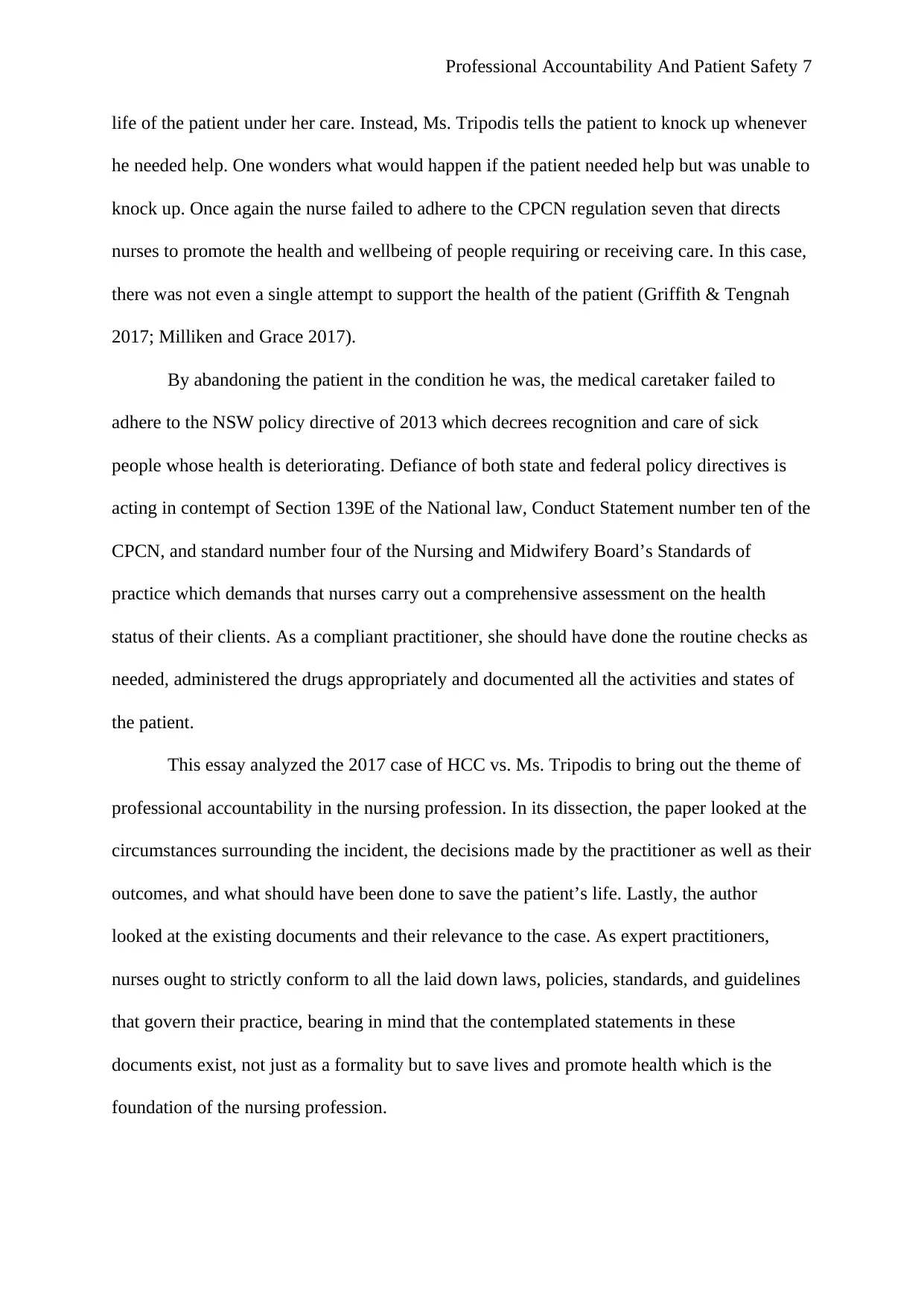
Professional Accountability And Patient Safety 7
life of the patient under her care. Instead, Ms. Tripodis tells the patient to knock up whenever
he needed help. One wonders what would happen if the patient needed help but was unable to
knock up. Once again the nurse failed to adhere to the CPCN regulation seven that directs
nurses to promote the health and wellbeing of people requiring or receiving care. In this case,
there was not even a single attempt to support the health of the patient (Griffith & Tengnah
2017; Milliken and Grace 2017).
By abandoning the patient in the condition he was, the medical caretaker failed to
adhere to the NSW policy directive of 2013 which decrees recognition and care of sick
people whose health is deteriorating. Defiance of both state and federal policy directives is
acting in contempt of Section 139E of the National law, Conduct Statement number ten of the
CPCN, and standard number four of the Nursing and Midwifery Board’s Standards of
practice which demands that nurses carry out a comprehensive assessment on the health
status of their clients. As a compliant practitioner, she should have done the routine checks as
needed, administered the drugs appropriately and documented all the activities and states of
the patient.
This essay analyzed the 2017 case of HCC vs. Ms. Tripodis to bring out the theme of
professional accountability in the nursing profession. In its dissection, the paper looked at the
circumstances surrounding the incident, the decisions made by the practitioner as well as their
outcomes, and what should have been done to save the patient’s life. Lastly, the author
looked at the existing documents and their relevance to the case. As expert practitioners,
nurses ought to strictly conform to all the laid down laws, policies, standards, and guidelines
that govern their practice, bearing in mind that the contemplated statements in these
documents exist, not just as a formality but to save lives and promote health which is the
foundation of the nursing profession.
life of the patient under her care. Instead, Ms. Tripodis tells the patient to knock up whenever
he needed help. One wonders what would happen if the patient needed help but was unable to
knock up. Once again the nurse failed to adhere to the CPCN regulation seven that directs
nurses to promote the health and wellbeing of people requiring or receiving care. In this case,
there was not even a single attempt to support the health of the patient (Griffith & Tengnah
2017; Milliken and Grace 2017).
By abandoning the patient in the condition he was, the medical caretaker failed to
adhere to the NSW policy directive of 2013 which decrees recognition and care of sick
people whose health is deteriorating. Defiance of both state and federal policy directives is
acting in contempt of Section 139E of the National law, Conduct Statement number ten of the
CPCN, and standard number four of the Nursing and Midwifery Board’s Standards of
practice which demands that nurses carry out a comprehensive assessment on the health
status of their clients. As a compliant practitioner, she should have done the routine checks as
needed, administered the drugs appropriately and documented all the activities and states of
the patient.
This essay analyzed the 2017 case of HCC vs. Ms. Tripodis to bring out the theme of
professional accountability in the nursing profession. In its dissection, the paper looked at the
circumstances surrounding the incident, the decisions made by the practitioner as well as their
outcomes, and what should have been done to save the patient’s life. Lastly, the author
looked at the existing documents and their relevance to the case. As expert practitioners,
nurses ought to strictly conform to all the laid down laws, policies, standards, and guidelines
that govern their practice, bearing in mind that the contemplated statements in these
documents exist, not just as a formality but to save lives and promote health which is the
foundation of the nursing profession.
Paraphrase This Document
Need a fresh take? Get an instant paraphrase of this document with our AI Paraphraser
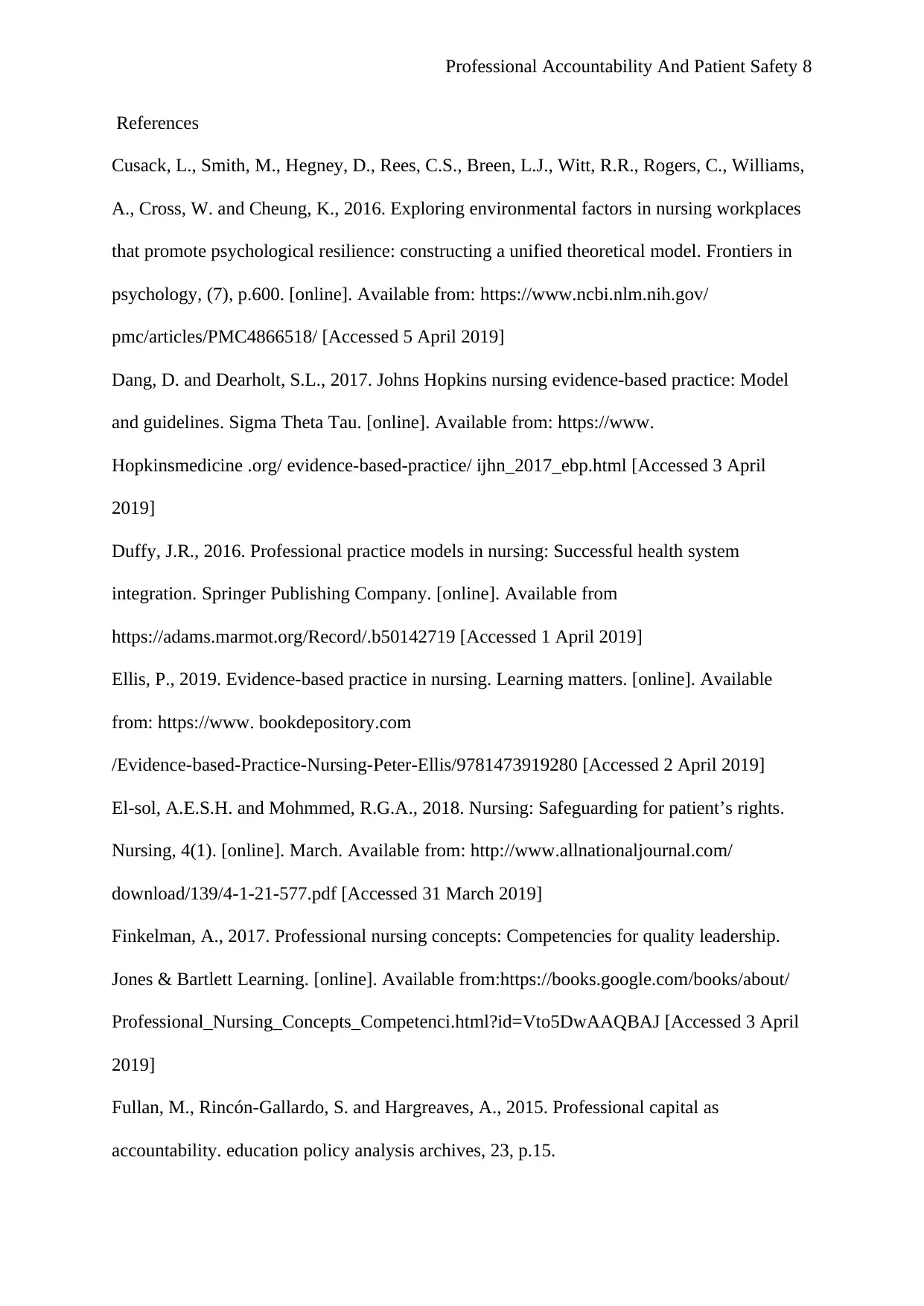
Professional Accountability And Patient Safety 8
References
Cusack, L., Smith, M., Hegney, D., Rees, C.S., Breen, L.J., Witt, R.R., Rogers, C., Williams,
A., Cross, W. and Cheung, K., 2016. Exploring environmental factors in nursing workplaces
that promote psychological resilience: constructing a unified theoretical model. Frontiers in
psychology, (7), p.600. [online]. Available from: https://www.ncbi.nlm.nih.gov/
pmc/articles/PMC4866518/ [Accessed 5 April 2019]
Dang, D. and Dearholt, S.L., 2017. Johns Hopkins nursing evidence-based practice: Model
and guidelines. Sigma Theta Tau. [online]. Available from: https://www.
Hopkinsmedicine .org/ evidence-based-practice/ ijhn_2017_ebp.html [Accessed 3 April
2019]
Duffy, J.R., 2016. Professional practice models in nursing: Successful health system
integration. Springer Publishing Company. [online]. Available from
https://adams.marmot.org/Record/.b50142719 [Accessed 1 April 2019]
Ellis, P., 2019. Evidence-based practice in nursing. Learning matters. [online]. Available
from: https://www. bookdepository.com
/Evidence-based-Practice-Nursing-Peter-Ellis/9781473919280 [Accessed 2 April 2019]
El-sol, A.E.S.H. and Mohmmed, R.G.A., 2018. Nursing: Safeguarding for patient’s rights.
Nursing, 4(1). [online]. March. Available from: http://www.allnationaljournal.com/
download/139/4-1-21-577.pdf [Accessed 31 March 2019]
Finkelman, A., 2017. Professional nursing concepts: Competencies for quality leadership.
Jones & Bartlett Learning. [online]. Available from:https://books.google.com/books/about/
Professional_Nursing_Concepts_Competenci.html?id=Vto5DwAAQBAJ [Accessed 3 April
2019]
Fullan, M., Rincón-Gallardo, S. and Hargreaves, A., 2015. Professional capital as
accountability. education policy analysis archives, 23, p.15.
References
Cusack, L., Smith, M., Hegney, D., Rees, C.S., Breen, L.J., Witt, R.R., Rogers, C., Williams,
A., Cross, W. and Cheung, K., 2016. Exploring environmental factors in nursing workplaces
that promote psychological resilience: constructing a unified theoretical model. Frontiers in
psychology, (7), p.600. [online]. Available from: https://www.ncbi.nlm.nih.gov/
pmc/articles/PMC4866518/ [Accessed 5 April 2019]
Dang, D. and Dearholt, S.L., 2017. Johns Hopkins nursing evidence-based practice: Model
and guidelines. Sigma Theta Tau. [online]. Available from: https://www.
Hopkinsmedicine .org/ evidence-based-practice/ ijhn_2017_ebp.html [Accessed 3 April
2019]
Duffy, J.R., 2016. Professional practice models in nursing: Successful health system
integration. Springer Publishing Company. [online]. Available from
https://adams.marmot.org/Record/.b50142719 [Accessed 1 April 2019]
Ellis, P., 2019. Evidence-based practice in nursing. Learning matters. [online]. Available
from: https://www. bookdepository.com
/Evidence-based-Practice-Nursing-Peter-Ellis/9781473919280 [Accessed 2 April 2019]
El-sol, A.E.S.H. and Mohmmed, R.G.A., 2018. Nursing: Safeguarding for patient’s rights.
Nursing, 4(1). [online]. March. Available from: http://www.allnationaljournal.com/
download/139/4-1-21-577.pdf [Accessed 31 March 2019]
Finkelman, A., 2017. Professional nursing concepts: Competencies for quality leadership.
Jones & Bartlett Learning. [online]. Available from:https://books.google.com/books/about/
Professional_Nursing_Concepts_Competenci.html?id=Vto5DwAAQBAJ [Accessed 3 April
2019]
Fullan, M., Rincón-Gallardo, S. and Hargreaves, A., 2015. Professional capital as
accountability. education policy analysis archives, 23, p.15.
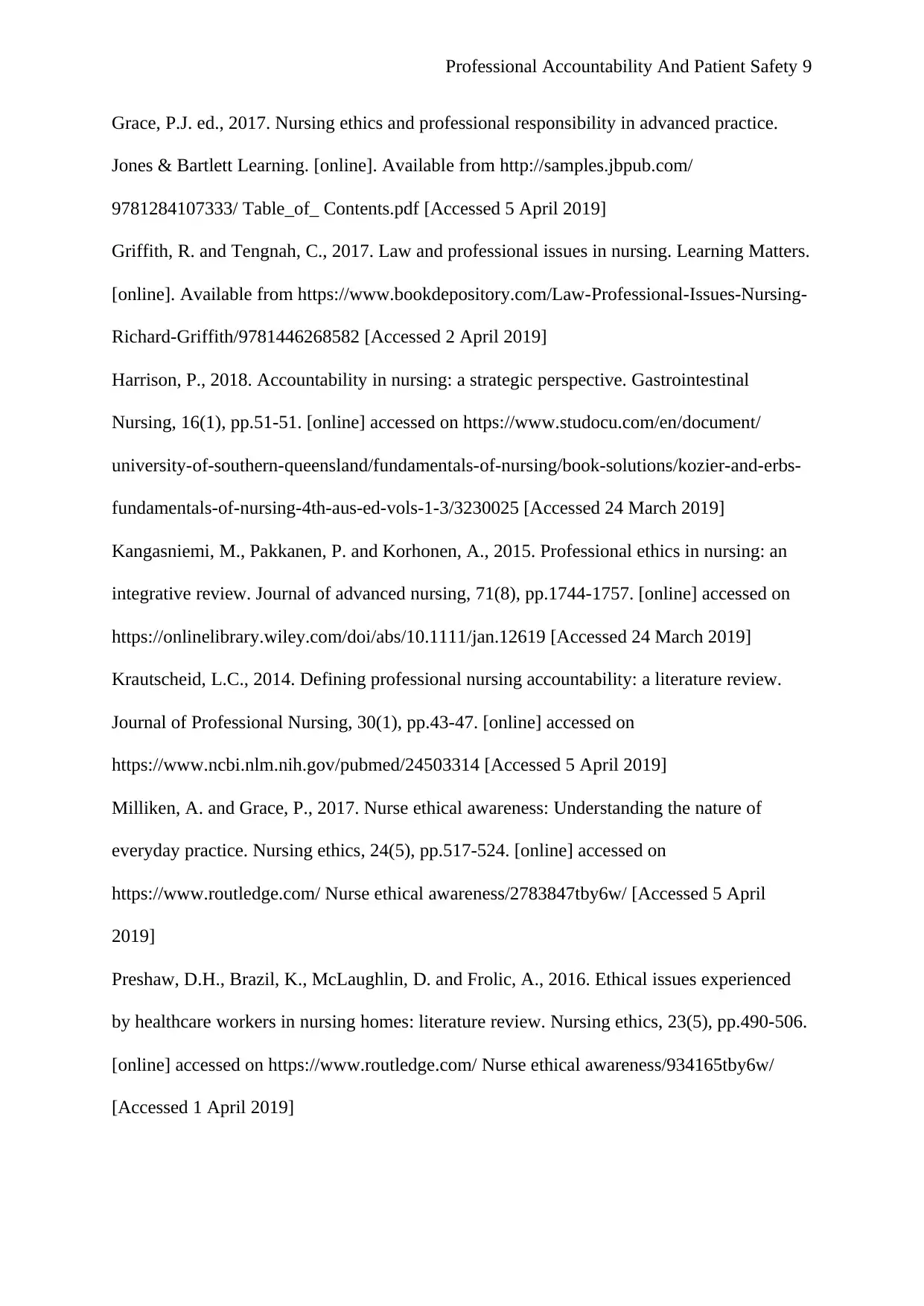
Professional Accountability And Patient Safety 9
Grace, P.J. ed., 2017. Nursing ethics and professional responsibility in advanced practice.
Jones & Bartlett Learning. [online]. Available from http://samples.jbpub.com/
9781284107333/ Table_of_ Contents.pdf [Accessed 5 April 2019]
Griffith, R. and Tengnah, C., 2017. Law and professional issues in nursing. Learning Matters.
[online]. Available from https://www.bookdepository.com/Law-Professional-Issues-Nursing-
Richard-Griffith/9781446268582 [Accessed 2 April 2019]
Harrison, P., 2018. Accountability in nursing: a strategic perspective. Gastrointestinal
Nursing, 16(1), pp.51-51. [online] accessed on https://www.studocu.com/en/document/
university-of-southern-queensland/fundamentals-of-nursing/book-solutions/kozier-and-erbs-
fundamentals-of-nursing-4th-aus-ed-vols-1-3/3230025 [Accessed 24 March 2019]
Kangasniemi, M., Pakkanen, P. and Korhonen, A., 2015. Professional ethics in nursing: an
integrative review. Journal of advanced nursing, 71(8), pp.1744-1757. [online] accessed on
https://onlinelibrary.wiley.com/doi/abs/10.1111/jan.12619 [Accessed 24 March 2019]
Krautscheid, L.C., 2014. Defining professional nursing accountability: a literature review.
Journal of Professional Nursing, 30(1), pp.43-47. [online] accessed on
https://www.ncbi.nlm.nih.gov/pubmed/24503314 [Accessed 5 April 2019]
Milliken, A. and Grace, P., 2017. Nurse ethical awareness: Understanding the nature of
everyday practice. Nursing ethics, 24(5), pp.517-524. [online] accessed on
https://www.routledge.com/ Nurse ethical awareness/2783847tby6w/ [Accessed 5 April
2019]
Preshaw, D.H., Brazil, K., McLaughlin, D. and Frolic, A., 2016. Ethical issues experienced
by healthcare workers in nursing homes: literature review. Nursing ethics, 23(5), pp.490-506.
[online] accessed on https://www.routledge.com/ Nurse ethical awareness/934165tby6w/
[Accessed 1 April 2019]
Grace, P.J. ed., 2017. Nursing ethics and professional responsibility in advanced practice.
Jones & Bartlett Learning. [online]. Available from http://samples.jbpub.com/
9781284107333/ Table_of_ Contents.pdf [Accessed 5 April 2019]
Griffith, R. and Tengnah, C., 2017. Law and professional issues in nursing. Learning Matters.
[online]. Available from https://www.bookdepository.com/Law-Professional-Issues-Nursing-
Richard-Griffith/9781446268582 [Accessed 2 April 2019]
Harrison, P., 2018. Accountability in nursing: a strategic perspective. Gastrointestinal
Nursing, 16(1), pp.51-51. [online] accessed on https://www.studocu.com/en/document/
university-of-southern-queensland/fundamentals-of-nursing/book-solutions/kozier-and-erbs-
fundamentals-of-nursing-4th-aus-ed-vols-1-3/3230025 [Accessed 24 March 2019]
Kangasniemi, M., Pakkanen, P. and Korhonen, A., 2015. Professional ethics in nursing: an
integrative review. Journal of advanced nursing, 71(8), pp.1744-1757. [online] accessed on
https://onlinelibrary.wiley.com/doi/abs/10.1111/jan.12619 [Accessed 24 March 2019]
Krautscheid, L.C., 2014. Defining professional nursing accountability: a literature review.
Journal of Professional Nursing, 30(1), pp.43-47. [online] accessed on
https://www.ncbi.nlm.nih.gov/pubmed/24503314 [Accessed 5 April 2019]
Milliken, A. and Grace, P., 2017. Nurse ethical awareness: Understanding the nature of
everyday practice. Nursing ethics, 24(5), pp.517-524. [online] accessed on
https://www.routledge.com/ Nurse ethical awareness/2783847tby6w/ [Accessed 5 April
2019]
Preshaw, D.H., Brazil, K., McLaughlin, D. and Frolic, A., 2016. Ethical issues experienced
by healthcare workers in nursing homes: literature review. Nursing ethics, 23(5), pp.490-506.
[online] accessed on https://www.routledge.com/ Nurse ethical awareness/934165tby6w/
[Accessed 1 April 2019]
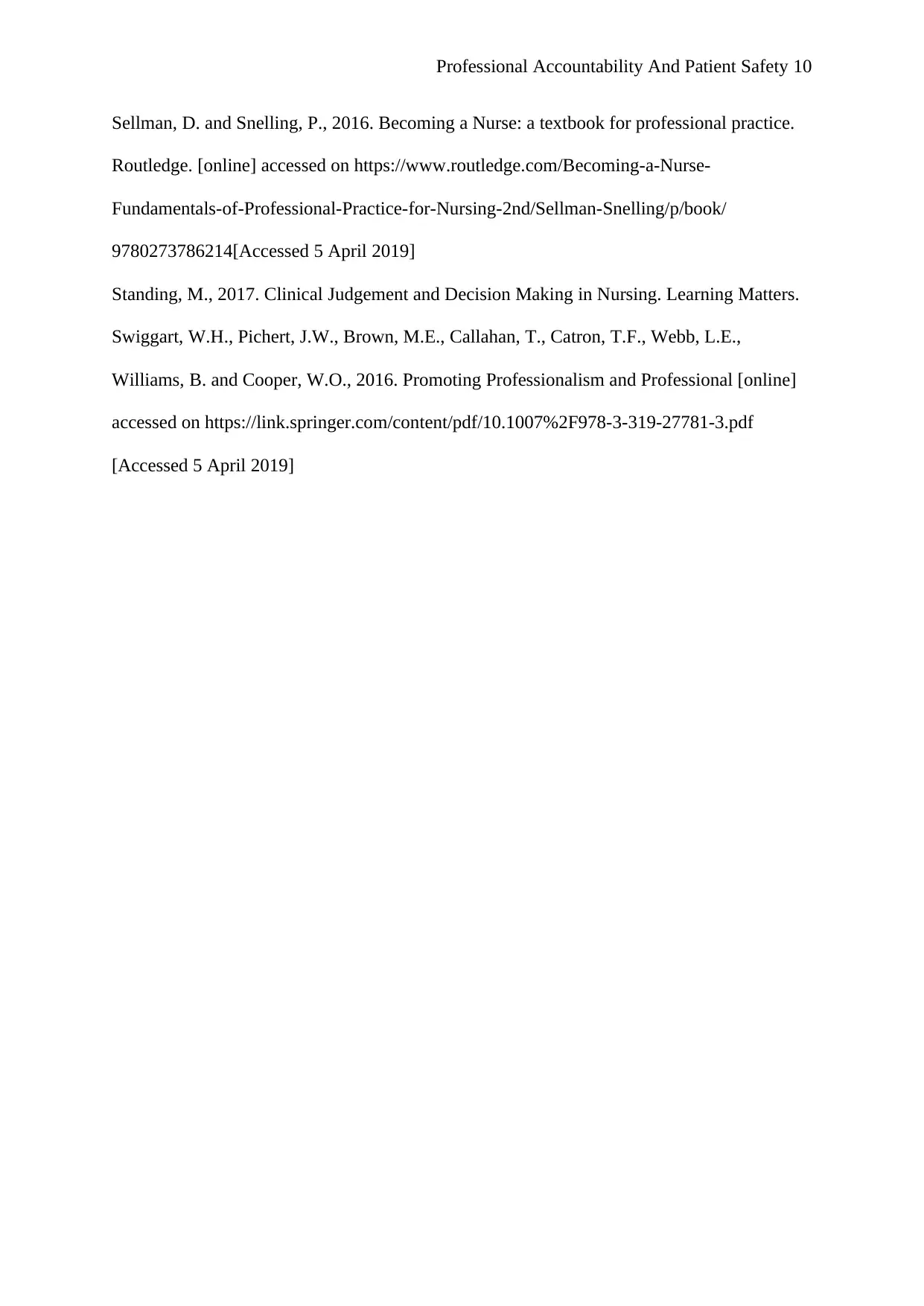
Professional Accountability And Patient Safety 10
Sellman, D. and Snelling, P., 2016. Becoming a Nurse: a textbook for professional practice.
Routledge. [online] accessed on https://www.routledge.com/Becoming-a-Nurse-
Fundamentals-of-Professional-Practice-for-Nursing-2nd/Sellman-Snelling/p/book/
9780273786214[Accessed 5 April 2019]
Standing, M., 2017. Clinical Judgement and Decision Making in Nursing. Learning Matters.
Swiggart, W.H., Pichert, J.W., Brown, M.E., Callahan, T., Catron, T.F., Webb, L.E.,
Williams, B. and Cooper, W.O., 2016. Promoting Professionalism and Professional [online]
accessed on https://link.springer.com/content/pdf/10.1007%2F978-3-319-27781-3.pdf
[Accessed 5 April 2019]
Sellman, D. and Snelling, P., 2016. Becoming a Nurse: a textbook for professional practice.
Routledge. [online] accessed on https://www.routledge.com/Becoming-a-Nurse-
Fundamentals-of-Professional-Practice-for-Nursing-2nd/Sellman-Snelling/p/book/
9780273786214[Accessed 5 April 2019]
Standing, M., 2017. Clinical Judgement and Decision Making in Nursing. Learning Matters.
Swiggart, W.H., Pichert, J.W., Brown, M.E., Callahan, T., Catron, T.F., Webb, L.E.,
Williams, B. and Cooper, W.O., 2016. Promoting Professionalism and Professional [online]
accessed on https://link.springer.com/content/pdf/10.1007%2F978-3-319-27781-3.pdf
[Accessed 5 April 2019]
1 out of 10
Related Documents
Your All-in-One AI-Powered Toolkit for Academic Success.
+13062052269
info@desklib.com
Available 24*7 on WhatsApp / Email
![[object Object]](/_next/static/media/star-bottom.7253800d.svg)
Unlock your academic potential
© 2024 | Zucol Services PVT LTD | All rights reserved.





